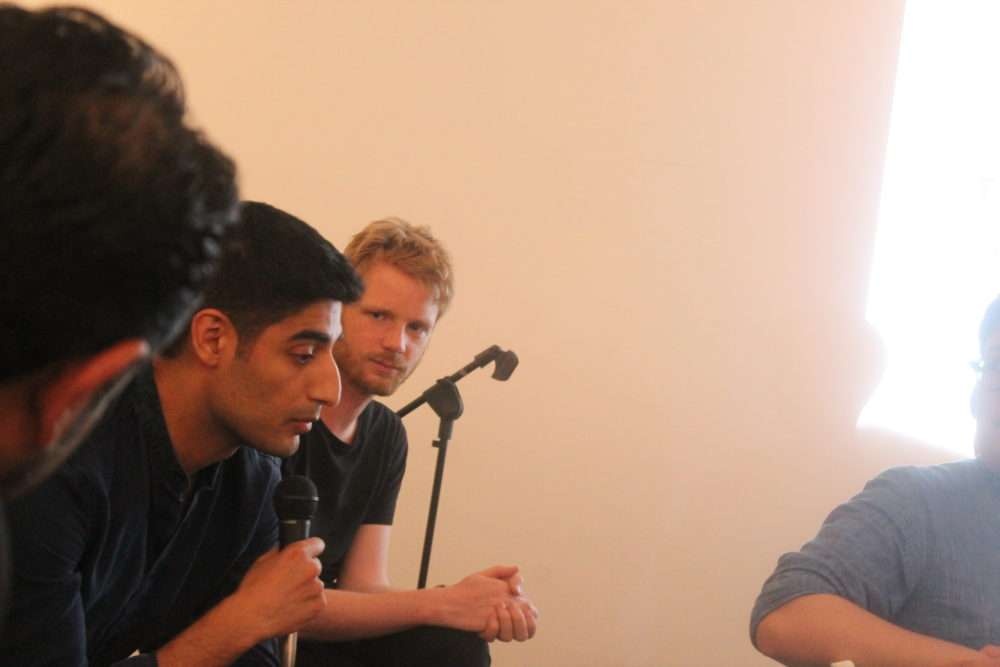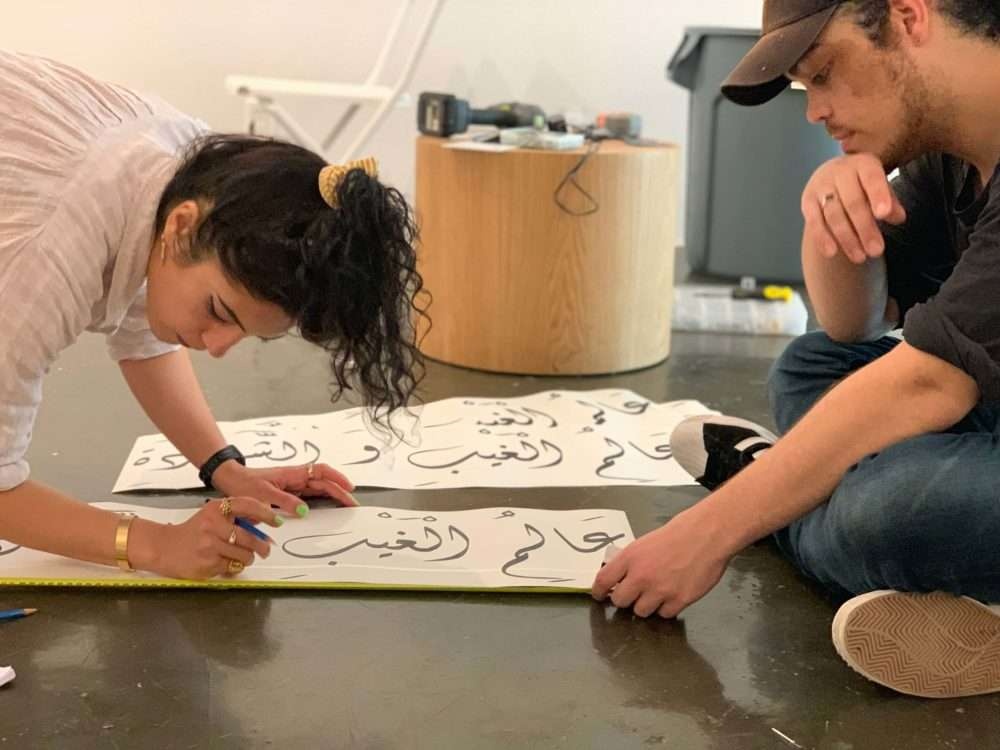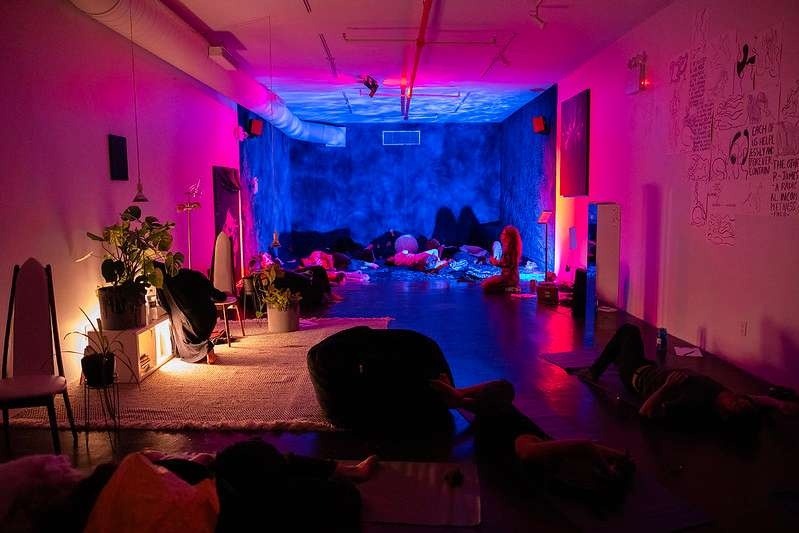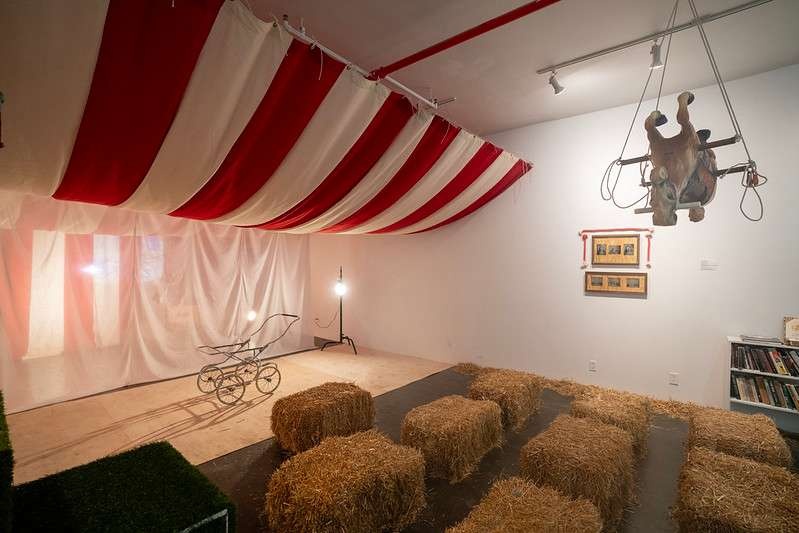Have You Seen Mohammad? Or, Finding Tender Nuance Amidst These Sinister Screens
Adina Glickstein
I. The present condition: we can neither confirm nor deny.
The development of cinema into the twenty-first century has been one of disappearance and re-emergence, the decline of the traditional theatrical dispositive, and concurrent, vast materialization of many little screens flooding into the spaces left behind. As I sit with Monalisa on the floor of the as-yet unfurnished gallery, Life of Mohammad has been open to the public for two weeks. The material apparatus of a video installation—or “artist’s moving image,” that slippery signature of the fine-art tendency in our moment of exploded cinematic possibility—is, at the moment, nowhere in sight.


Artist Maryam Monalisa Gharavi’s desk at Recess
Where does Life of Mohammad live as of this writing? What is its body, its film-text? Impressions from Monalisa’s proposal: a prismatic installation setup is planned to construct a single hypothetical story from seven real Mohammads, non-actors, New Yorkers. She sends me a voice memo. She had a breakthrough (not today, but this week—a breakthrough exists in duration, like a film) and is fashioning other materials, “contingent objects but more than ephemera”: artist’s books, t-shirts, a second, shorter film. All these pieces coalesce into a speculative outline, a not-yet-film whose final form is perhaps best apprehended by sketching out what it is not.
Steven Shaviro writes of the postcinematic as the defeat of Big Screen’s cultural dominance, giving way to digital innovations, ubiquitous and portable and excitingly, though also unnervingly, unfixed. [1] Cinema as “discussing future video installation, sitting together on gallery floor,” but also, “cinema as surveillant assemblage.” Two parallel tendencies anxiously underlie the current proliferation of moving images: on the one hand, the glow of possibility, not unlike the sedative glow of a screen; on the other, the threatening prospect that, rather than remaking the cinema, our new moving image culture is remaking us.
II. Where there is danger…
It’s mid-September. Last Tuesday, 9/11, was an open casting call, searching for Mohammads to populate the film—Monalisa’s first event in the gallery. We sat in a loose constellation of folding chairs clustered in the still mostly-empty space, which is maybe where you’re reading this now. This is a zone of becoming-cinema, moving images materializing, being and bringing-forth. Four Mohammads showed up that night and spoke to the intertwined adversity and beauty of living under their common name. Across their spectrum of experiences, one emphatic through-line: each man’s life changed dramatically seventeen years ago that day. “After 9/11,” recalled one Mohammad, federal agents descended on his neighborhood. “They picked up 500 people…just because the name Mohammad matched in a database from the Department of Motor Vehicles…People were afraid. They did not go home.” To be a Mohammad was at that moment to become hyper-visible—to be reduced to data, devoid of human biography, and to be targeted.


An event attendee named Mohammad speaks on his experience as a Muslim man in post-9/11 America
To borrow from Harun Farocki, this flattening might be called an “operational cinema”—a profusion of machinic recordings that act as they unfold, often occluded beyond the bounds of everyday human perception, often in the interest of techno-military imperatives. This is the preponderance of postcinema: a turn in the pattern of image-making where liberal questions of representation and inclusion collapse under the weighty danger of being seen.
Who is this operational cinema’s audience? The federal agents who left their cards on Mohammad’s neighbors’ doors? The machine-eyes of the unmanned predator drones whose proliferation was “justified” in the wake of 9/11? The authors of the obscure “disposition matrix” by which data profiles slip into designation as “enemy combatants,” justifying their extrajudicial execution? A drone operator’s terminal tucked safely away in Nevada relays images of war zones from a four-lens digital gyroscopic camera. Total visual domination, beyond IMAX’s wildest fabulation, transmitted on a wall-sized monitor.[2] Perception = conquest = joystick-flip = kill. To borrow from Jonathan Beller: the message is murder. The operational postcinema collapses necropolitics into the camera’s field of vision; here, the cinema’s afterlife is built around the inextricability of seeing and shooting. To be visible—or to be made visible, which is to be made accessible for the exigencies of borderless global military intervention—is to face the fundamental emptiness at the center of liberalism’s promise of benevolence. For some more than others, to be seen is to be caught within the crosshairs.


Artist Maryam Monalisa Gharavi works with an Assembly Peer Leader to install a floor to ceiling vinyl that reads, عالم الغيب والشهادة, which translates roughly as, “The Knower of the Unseen and Seen,”.
III. So grows the saving grace also.
Where the tragedy of hypervisibility flattens death into data, Monalisa posits an alternate postcinema that explores the architecture of caring intersubjectivity. Her hypothetical future Mohammad, woven from the tender details that can’t be reduced to biometric data or read as surface impressions on the skin, will live as part of an expansive filmmaking practice that foregrounds liveness and shared affective bonds, solidarity and connection—precisely of the sort established at the casting call that evening. With attention to the matrix of safety and concealment—who might notice that she’s compiling a list of Mohammads?, she wonders out loud during one of my visits to the in-process show—Monalisa stages questions of visibility and vulnerability, envisioning a postcinema that constitutes life where the mainstream threatens it.
Life of Mohammad is processual by design. The film, as it unfolds through these early stages, is already a space of liveness. The liveness of history folded into its production process, as each studio visit, WhatsApp conversation, and public event at the gallery flows through and eventually settles into my spectatorial body, impressing its duration. The liveness of invigoration, of feeling attuned to new life. There’s an evident cinematic quality to watching it all come together, a montage of off-the-cuff videos of gallery walkthroughs pinging my phone as new developments unfold. Recorded representation and lived experience bleed into one another; the disillusion of the cinematic apparatus invites us to trouble all those other old distinctions. By Monalisa’s account, the live film “fractures the frame.” It may invite on-screen spectatorship but may just as well exist outside it. [3] The instability of cinema’s definition becomes, paradoxically, the ground for a deeper sense of security. Not in the anxious neoliberal sense of securitization, that driver of crisis in the first place, but as a meaningful framework of interpersonal care. Against the grain of instrumentalized representation—a deadly, reductionist, binaristic logic—Monalisa’s expanded cinema is one of thoughtful dualities: the tender and the rigorous, the live and the recorded, the unseen and the seen.
Footnotes
-
Steven Shaviro, “What is the post-cinematic?” The Pinnochio Theory. Aug 11, 2011.
-
Tom Holert, “Sensorship: the Seen Unseen of Drone Warfare,” in Image Operations: Visual Media and Political Conflict ed. Jens Eder and Charlotte Klonk (Manchester: Manchester UP, 2017), 12.
-
Maryam Monalisa Gharavi, “Knowers of the Unseen and the Seen,” Artist Statement.
About the artist
Adina Glickstein
Explore/Archive
See allDecember 2025
The INSTITUTE FOR TRANSHUMANIST CEPHALOPOD EVOLUTION and Learning from Octopuses
Barbara London
Barbara London reflect's of Miriam SImun's INSTITUTE FOR TRANSHUMANIST CEPHALOPOD EVOLUTION
October 2025
streamlined reflections, courtesy of noise canceling headphones
Gabrielle Rucker
Gabrielle Rucker reflects on the radical intimacy and auditory life at the heart of Deli Radio
July 2025
Tell My Jockey: CUNTRY’s Discourse From the Horse’s Mouth
Ericka Pérez
Assembly fellow Ericka Pérez reflects on clowning, resistance, and CUNTRY’s radical refusal to perform.





